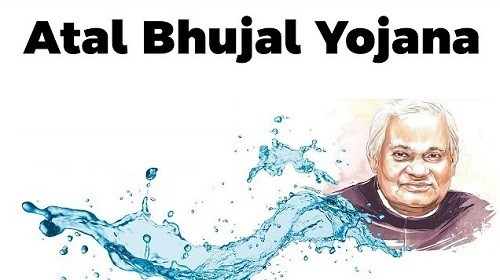Contents
What do you mean by Atal Bhujal Yojana (ABY)?
The objective of the yojana was to lay weight on the recharge of groundwater resources and refine the utilization of groundwater resources, with the involvement of humans at the local level.
- The yojana will be executed and looked over by the Ministry of Water Resources, which is now familiar as the Jal Shakti Ministry.
- Half of the cost of the yojana will be supported by the Gov., while the other half will be borne by the World Bank in the form of a loan.
- To cheer community participation, it has been planned by the gov. to offer 50% of the cash to gram panchayats and states as a stimulus for attaining groundwater management targets.
Objectives of Atal Bhujal Yojana
- It focuses on groundwater management in priority zones in the nations through community participation.
- Two crucial kinds of groundwater systems found in the country involve hard rock aquifers and alluvial. These are safeguarded under the yojana.
- Priority zones covered – Uttar Pradesh, Rajasthan, Maharashtra, Madhya Pradesh, Karnataka, Haryana, and Gujarat.
- These States act for about 25% of the total number of semi-critical, over-exploited, and critical blocks in terms of groundwater in the country.
- It also focuses on bringing about physiological change at the community level through capacity building and awareness programs for encouraging continual groundwater management in participating States.
Funding of the scheme
- Atal Bhujal Scheme is a Central Sector yojana with an outlay of INR 6000 crore, out of which INR 3,000 crore will be a loan from World Bank and INR 3,000 crore as a matching contribution from the Gov. of India.
- The funds under the program will be offered to the states as grants-in-aid.
- The World Bank financing shall be done under the new lending instrument, that is, PforR, wherein funds under the programs will be paid out from World Bank to the GoI based on attainment of pre-agreed results.
Scope of Atal Bhujal Yojana
The yojana foresee addressing some serious issues connected to sustainable groundwater management, that is,
- For sustainable groundwater management, State-specific institutional frameworks
- Improvement of groundwater recharge;
- Enhancement of water use efficiency; and
- Strengthen community-based institutions to encourage groundwater management.
Some possible investment categories which will be kept out from Atal Bhujal Yojana are:
- Construction of new large-scale irrigation systems and major dams; and
- Industrial wastewater collection, treatment, and utilizing it for refreshing groundwater.
- In addition, occupations that are likely to have an important adverse influence on the environment that is unprecedented, sensitive, or diverse and/or impact humans are not allowed for financing under the yojana.
- Similarly, activities that include the attainment of services, works, and goods of high-value contracts will normally not be qualified for financing.
India’s Ground Water Problem
- A research reported that almost 80% of the domestic water supplies [both urban and rural] depend on groundwater.
- As per another report by World Bank, India is held accountable for about 25% of the groundwater preoccupation due to its increased number of dark regions.
What do you mean by Groundwater Dark Zones?
- Regions where groundwater utilization is overexploited.
- Here the charge of annual consumption is more than the annual price of recharge of groundwater.
- The gov. keeps a record of such dark zones in the country and the states.
Scheme overview
ATAL JAL is an initiative to make certain longer-term sustainability of groundwater resources in the nation. The Department of Water Resources is adopting a mix of bottom-up and top-down approaches in identified groundwater stressed blocks in several states, representing a range of hydrogeologic, geomorphic, and climatic and cultural manners. ATAL JAL has been formed with the principal objective to strengthen the institutional framework. The project foresees undertaking this through different interventions, including improved agricultural practices, capacity building, the convergence of new/ongoing yojanas and awareness programs, etc. The motive of the yojana is to refine groundwater management in seven states of the country.
Coverage
The yojana focuses to refine groundwater management through community participation in identified priority zones in seven States. Execution of the yojana is expected to benefit nearly thousands of Gram Panchayats in numerous districts in these States.
Scheme components
ATAL JAL has two crucial components:
- Institutional Strengthen and Capacity Building Element to strengthen institutional arrangements for continual groundwater management in the States including strengthening of Water User Associations, improving monitoring networks, capacity building, etc.
- Incentive Component for inspiring the States for attainment in refined groundwater control practices namely, acquiring demand-side management practices, execution of management interventions through the convergence of ongoing yojanas, preparation of water security schemes, data dissemination, etc.
Expected results
ATAL JAL will result in:
- Institutional strengthen to improve groundwater capacity building and monitoring networks of stakeholders at various levels which will improve groundwater data storage, dissemination, exchange, and analysis.
- Realistic and Improved water budgeting based on a better database and devising of community-led Water Security schemes at the Panchayat level
- Execution of Water Security schemes through the convergence of different ongoing/new yojanas of the Gov. of India and State Gov. to facilitate effective and judicious use of funds for continual groundwater management. Well-organized usage of accessible groundwater resources with importance on demand-side measures like electricity feeder separation, micro-irrigation, crop diversification, etc.
Expected Impact
- Source feasibility for Jal Jeevan Mission in the yojana zone with working participation of local communities.
- Will give towards the aim of doubling the farmers’ income.
- Will encourage participatory groundwater management. Refined cropping pattern and refined water use efficiency on a mass scale.
- Promotion of equitable and efficient utilization of groundwater resources and behavioral change at the community level.
What is the aim of the Atal Bhujal Yojana?
Ans. ATAL JAL is a Central Sector plan for ease of feasible groundwater management. The plan lays prominence on demand-side interventions and community participation for feasible groundwater management in identified water-stressed zones in a few states of the nation.
How many states have been come under this Yojana?
Ans. The Atal Bhujal yojana has been absorbed in 8353 water-stressed Gram Panchayats of Uttar Pradesh, Rajasthan, Maharashtra, Madhya Pradesh, Karnataka, Gu, Gujarat, and Haryana.




